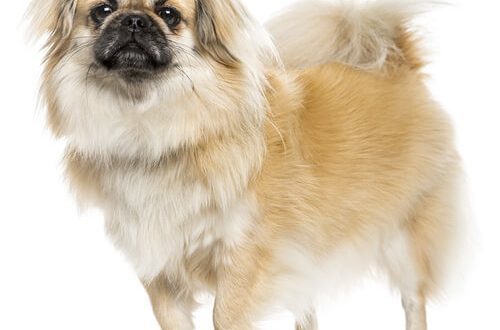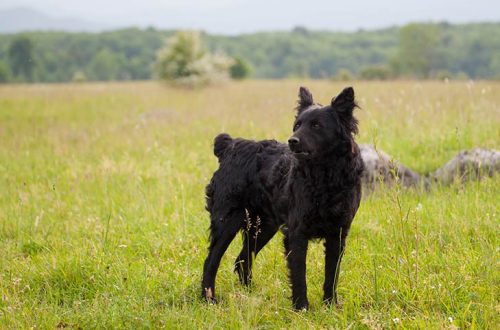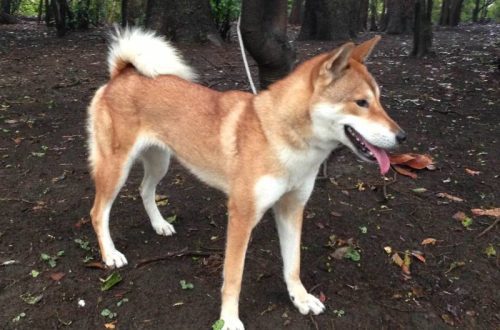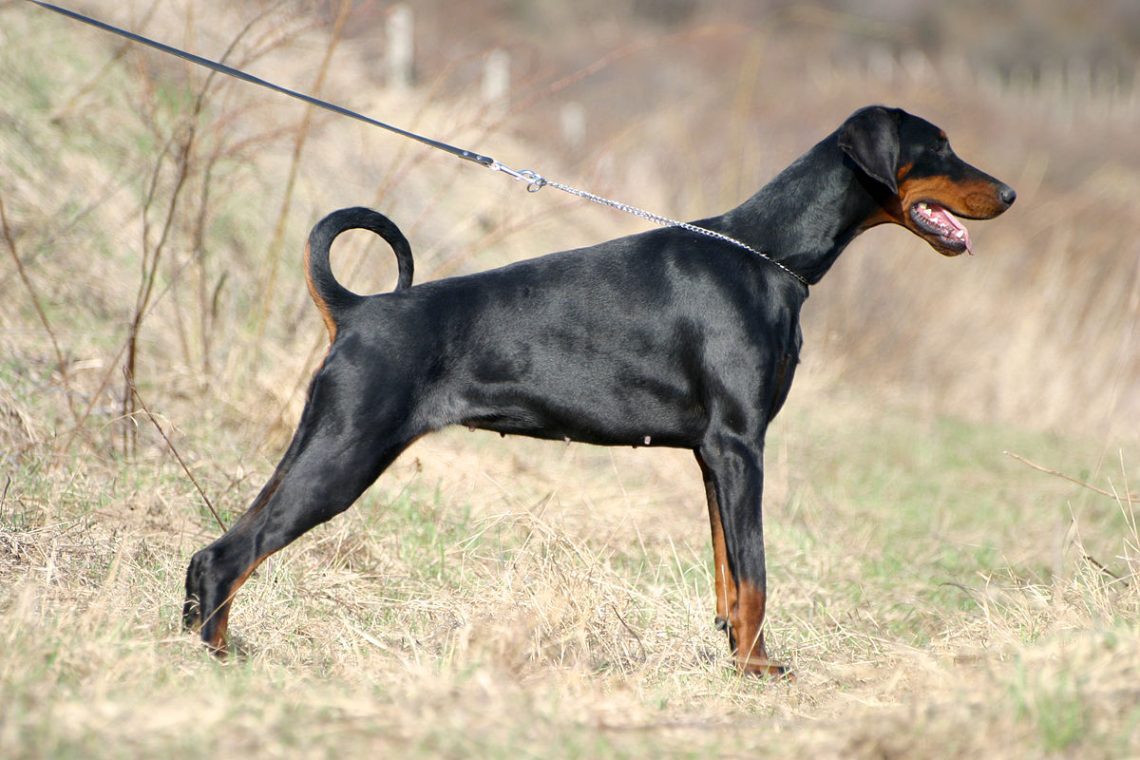
Doberman
Other names: Doberman Pinscher
Doberman is a dog that combines high intelligence and devotion, fearlessness and vigilance, strength and grace in the most amazing way.
ọdịnaya
Characteristics of Doberman
| Mba onye si | Germany |
| Hà | nnukwu |
| ibu | 65-69 cm |
| Arọ | 30-40 n'arọ |
| Age | ruo afọ iri na anọ |
| FCI ụdịdị otu | Pinscher na Schnauzers, Molossians, Mountain Dogs na Switzerland Anụ Nkịta |
Oge nkiti
- It is difficult to find a more versatile dog than a Doberman. This is a protector, and a companion, and a faithful companion, and just a family favorite. These animals are confidently included in the top lists of the most popular breeds in many countries of the world.
- The Doberman is infinitely devoted to his owner and his family, and is quite friendly to familiar people and pets. For all his temperament, he does not lose vigilance for a second and is always ready to help.
- Dogs of this breed need constant physical activity. They have excellent performance and a high degree of trainability. That is why it is important to properly raise a pet in order to direct all its natural inclinations in the right direction.
- Natural intelligence, efficiency, inexhaustible desire to learn something new make it possible to achieve the most amazing results in working with a dog. Doberman can do everything – if this is an exaggeration, then it is very insignificant.
- With all its positive qualities and good natural inclinations, the Doberman is a dog that is not suitable for everyone. A person who is phlegmatic, indifferent, or, conversely, with an explosive unstable character, will never be able to reveal all the advantages of a dog.
- This dog instinctively feels “what is good and what is bad”, whether it is about a person or a specific situation.
- Doberman by its nature is an animal with a balanced psyche, which, with the right approach, is able to reveal to you the best qualities of its canine soul.
- The common opinion among the inhabitants that the dogs of this breed are hysterical and evil is fundamentally wrong. Doberman aggression is only a response to the living conditions in which he grows and is brought up.
- Doberman is an aristocratic dog. Having such a strong, intelligent, loyal and loyal dog at home is a reason for pride.
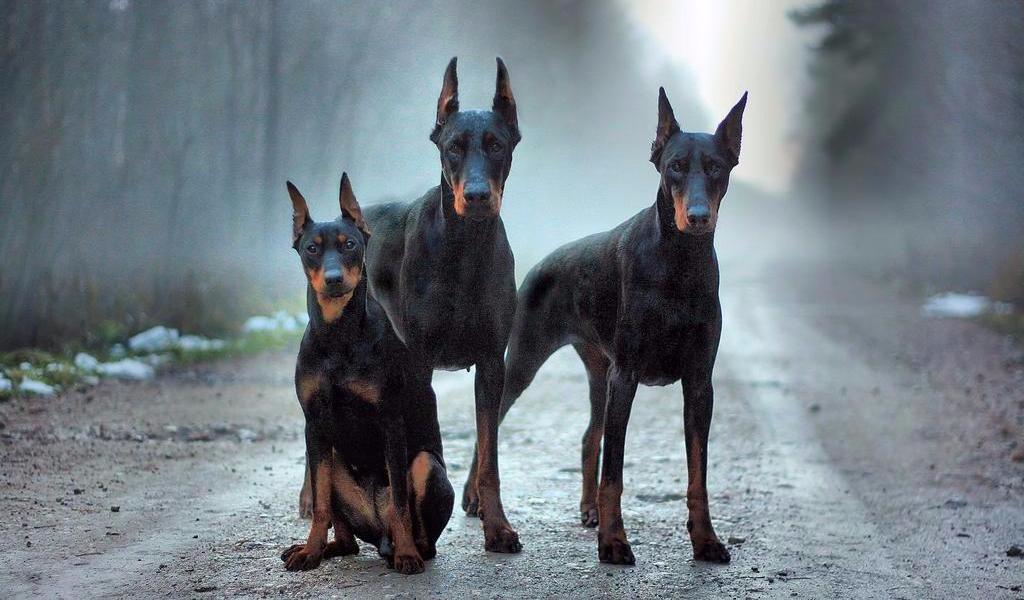
Doberman is a breed that is confidently in the top 20 in terms of popularity. To the question: “What are these animals famous for?” – experts will tell you about the legendary Tref, a police Doberman who served in the St. Petersburg police at the beginning of the 20th century. With its help, more than 1500 crimes were solved. Experts will also offer to read Yesenin, in which you will find the lines: “Give me a paw, for good luck, Jim. I have never seen such a paw…” And how many more stories about this wonderful dog you will hear…
Akụkọ banyere ụdị Doberman
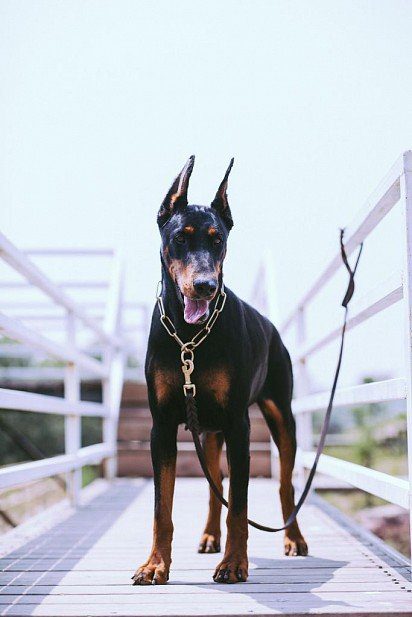
Carl Friedrich Louis Dobermann – this is the full name of the man who became the creator of the dog breed so popular in our time. A native of the small German town of Alpoda, he changed many professions, including tax collector and night policeman. It was during this period that Karl thought about breeding a breed that would best meet the service requirements. According to Dobermann, such a dog should have been of medium height, smooth-haired, harmoniously combining intellectual qualities with vigilance and physical endurance. Constantly attending exhibitions and sales of animals, which began to take place regularly in Apolda since 1860, he selected the most suitable animals for breeding work.
In 1880, Dobermann, together with friends, bought a small house and began to come to grips with breeding a new breed. Soon came the first success. Dobermann dogs were purchased with pleasure by numerous customers. Today it is difficult to establish which breeds were used in breeding, since no records of the progress and results of selection were kept. It can be assumed that among the ancestors of the Doberman there were Old German Pinschers, Bosserons Shepherd Dogs, Rottweilers . It is possible that the Manchester black and tan terrier, the blue dog, the pointer and even the mastiff could leave their mark. The main thing remains that the result was a dog with surprisingly diverse and pronounced characteristics.
The breed was originally called the Thuringian Pinscher. Another resident of Apolda, named Otto Goeller (Holler), was seriously engaged in its improvement. He managed to somewhat soften the overly aggressive nature of the dog, make it more docile and obedient, without sacrificing the amazing abilities for security and watchdog service.
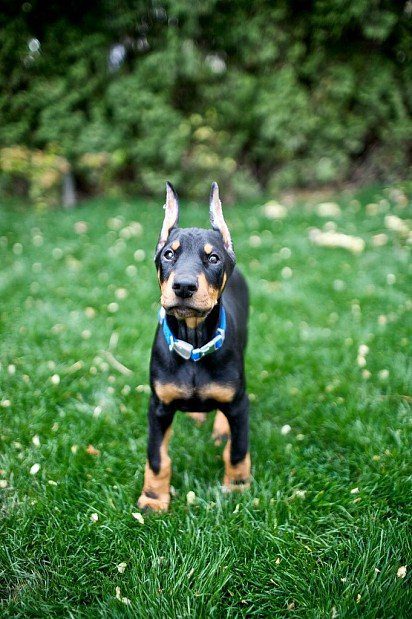
Not done in the history of the Dobermans and without curiosities. Goeller’s neighbor so actively expressed his dissatisfaction with the noise and barking constantly coming from Otto’s house that the latter was forced to give away most of the dogs, leaving only a few representatives of the new breed. This gave an additional impetus to its distribution and contributed to the growth of popularity.
In 1894, after the death of Karl Dobermann, in memory of his merits, the breed was renamed the Doberman Pinscher. In 1897, a special show was organized in Erfurt, Germany, and an official presentation took place. In 1899, the Apolda Doberman Pinscher of the Year club was created, and just a year later, due to the huge increase in the popularity of animals, it was renamed the National Doberman Pinscher Club of Germany. The breed began its triumphal march across Europe, and then around the world.
In Russia, the wide distribution of Dobermans occurred at the very beginning of the 20th century.
In 1949, the second word was removed from the name of the breed, since the leading cynologists considered the assignment of this dog to the Pinscher group incorrect.
In February 1994, the Fédération Cynologique Internationale (FCI) entered the Doberman breed in its registry under No. 143, indicating Germany as its country of origin.
Video: Doberman
Doberman appearance
Doberman is a medium-sized dog with a strong muscular body, harmoniously combining the nobility of posture with clarity and grace of lines. This is an ideal dog with an impeccable anatomical structure. It is simply impossible to hide the flaws in the exterior of a Doberman – he is all in sight. An ensemble of power, enormous internal energy with external grace and even some refinement – this is the first general impression of this breed.
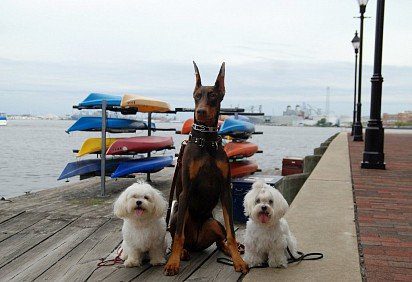

ibu
The height at the withers of the male is from 68 to 72 cm; females – 63-68 cm. Deviations in height in any direction by more than 2 cm are considered a disqualifying sign.
Ibu ibu
The mass of an adult male ranges from 40-45 kg, the female weighs from 32 to 35 kg.
ọdịdị
Doberman is a medium-sized animal with an elegant appearance, harmoniously developed muscles, without any signs of excessive massiveness and roughness of body outlines. The dog is more square than elongated. The height at the withers is approximately equal to (or slightly less than) the length of the body.
Head
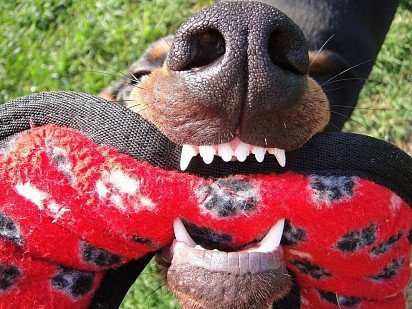

The Doberman’s head is commensurate in size with the general proportions. The shape, when viewed from above, resembles a blunt wedge. The line of the crown when viewed from the front is even, not falling to the ears. The stop is not sharp, but noticeable. The muscles are well developed. Cheekiness is absent.
Ekechila ọnụ
The length of the muzzle of the Doberman is almost the same as the length of the skull. The incision of the oral fissure reaches the molars. The mouth opens wide. The nose is broad, but not protruding. The color of the earlobe is black or a lighter shade, depending on the color of the animal. Lips – dry and well fitting to the jaws. Jaws – well developed, wide. Scissor bite.
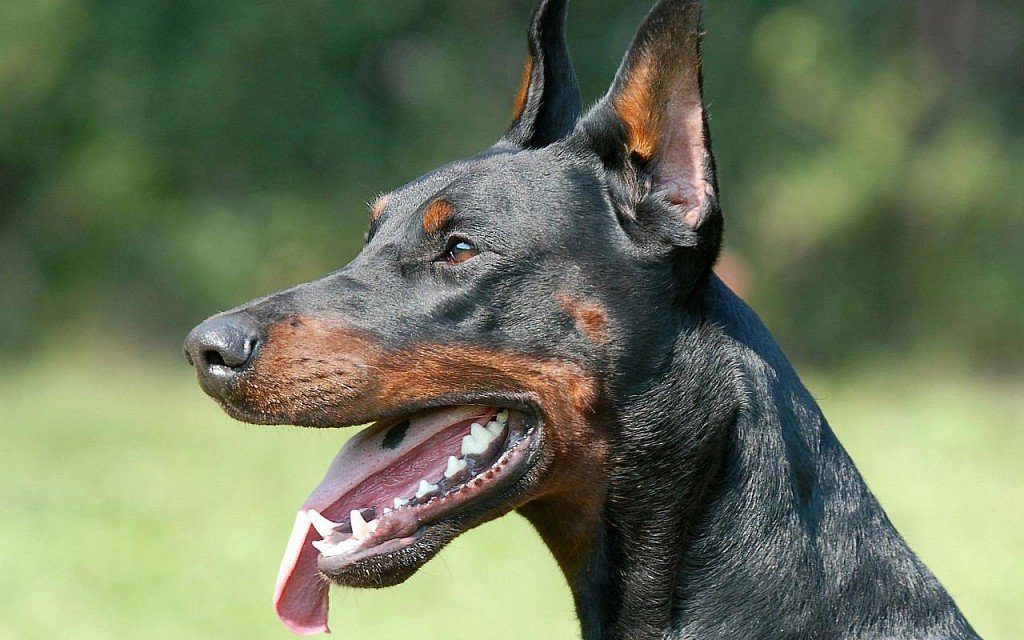

anya
Oval shape medium size. The color of the iris is dark. In brown Dobermans, a lighter shade of eyes is allowed.
Ntị
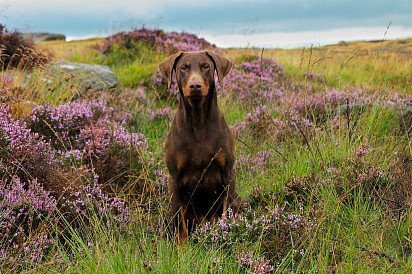

Doberman’s ears are set high. If docked, stand upright. In countries where cupping is prohibited, they should be of medium size, with the leading edge adjacent to the ear.
olu
Long, graceful, straight. Very muscular and strong.
Back
The protruding withers give rise to the line of the back. The dorsal and lumbar sections are short, only in bitches higher values of the elongation index are allowed. The croup is rounded.
Ara
Convex, wide with slightly protruding ribs. Well developed in front. The depth of the chest should be about half the height of the dog at the withers.
Ụda
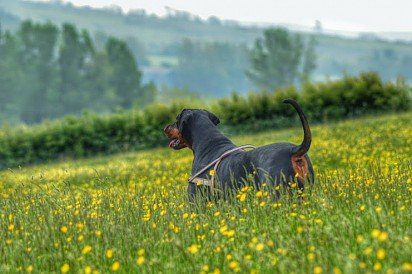

The tail of the Doberman is set high, docked very shortly – only two vertebrae remain visible. Where this operation is prohibited by law, a natural tail is permitted.
Ụkwụ n'ihu
Vertical, straight when viewed from any angle. The muscles are developed.
ụkwụ azụ
Straight, parallel. Thighs with well-defined strong muscles.
Wskwụ
Both the front and hind legs are short and tight. The nails are dark. The fingers are arched.
ajị anụ
The Doberman’s coat is short, fairly hard, smooth and thick. Evenly distributed throughout the body. Fits snugly, no undercoat.
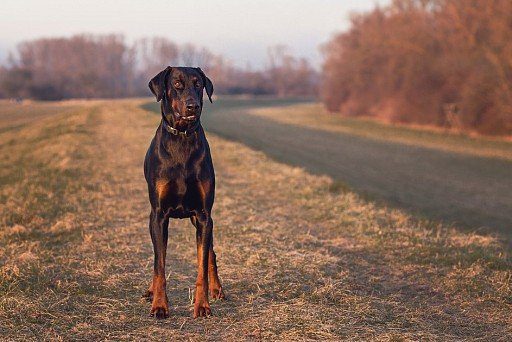

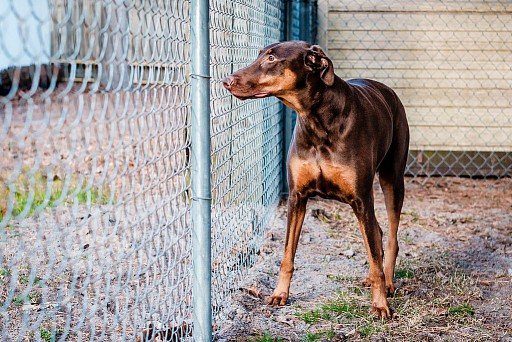

Agba
Black or brown. It is obligatory to have clearly visible, with well-defined boundaries, rusty-red tan marks on certain parts of the body.
Omume ọjọọ enwere ike


Breed defects include any deviation from the requirements of the standard.
The disqualifying signs are:
- in general appearance – a discrepancy between the dog’s appearance and gender (a male in a bitch type or vice versa), blue or yellow (wolf) eyes, malocclusion and lack of teeth;
- according to the condition of the coat – apparently elongated or wavy, rare with bald patches, the presence of white spots;
- by nature – timidity, nervousness and aggressiveness.
Photos of an adult doberman
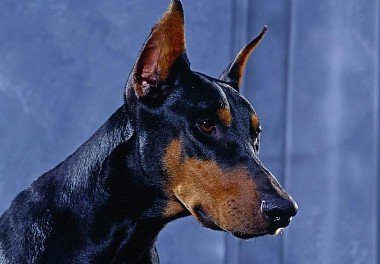

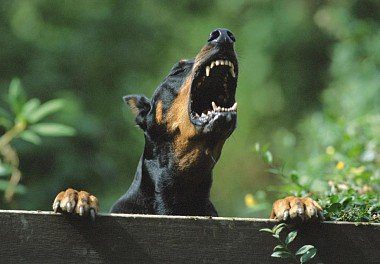

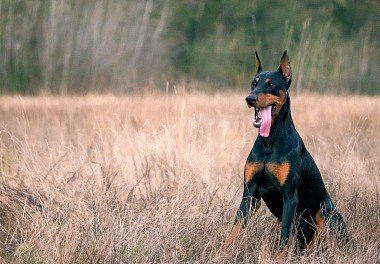

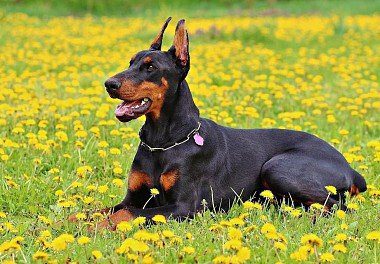

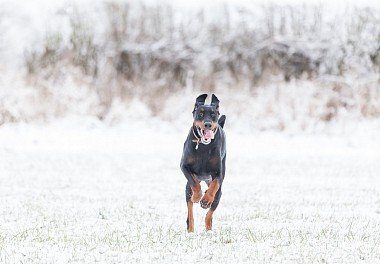

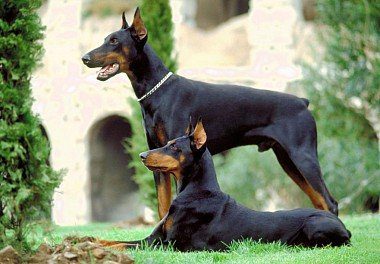

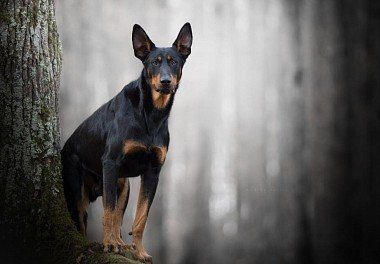

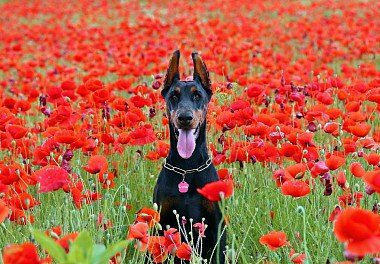

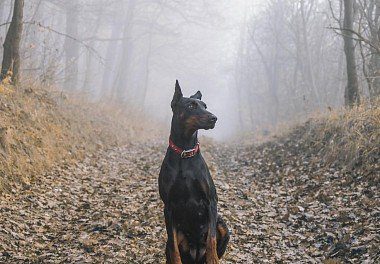

Doberman character
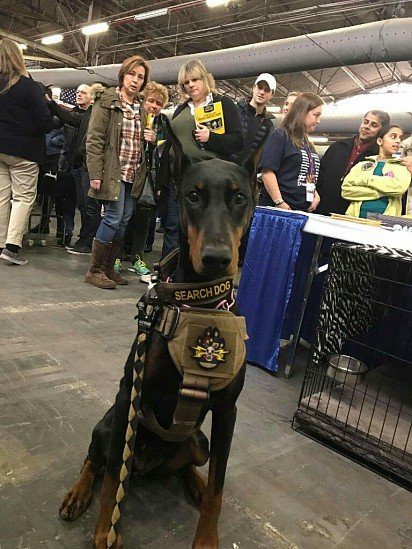

You have taken a Doberman into your house. What to expect from this dog, because opinions about the breed sometimes differ dramatically. Let’s try to deal with this issue.
The most capacious way to express the nature of the animal in one word is vigilance. His “karma” is to be always on the alert. This over-caution is by no means the result of fear and intimidation, it is rather a consequence of the genetically inherent ability to think in this way, the result of his mental activity.
With the similarity of characters, each dog of this breed is a personality, paradoxical as it sounds.
Many experts call the Doberman a dog with a human mind, because he is very easy to train and never forgets the lessons he has learned. However, only the owner, who has a sufficient level of intelligence and a balanced, calm character, can cope with a Doberman, raise and educate him.
In order to make sure that the Doberman is not an ordinary dog, watch him. Does he sleep, ride with you in the car, play with your kids? Take a closer look! He sleeps at home, rides in his seat, frolics with his little ones. Everything is perceived by this amazing animal as personal, own and directly in the area of his responsibility. He should be aware of all the events taking place in the house, and you, in his opinion, only provide him with everything he needs.
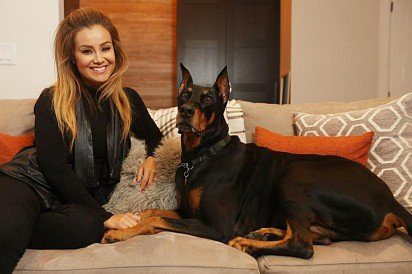

Initially, this breed was bred to perform certain tasks. And service Dobermans were brought up on the principle of unquestioning devotion to the owner and aggressive suspicion of a stranger. Hence the opinion about the Doberman as an evil inadequate creature. However, breeders managed to get rid of undesirable qualities while fully maintaining all performance characteristics, so that modern Dobermans are full-fledged family pets.
In no case should you, using the inclinations laid down by nature – strength, lack of fear, swiftness, intellect, – grow a “devil of hell” out of your Doberman. One of the most striking features of this dog is that he himself is able to understand the difference between good and bad, and to educate him with methods of bitterness and terror is simply a crime.
Doberman is a loving and very intelligent friend, a top-class security guard, a dog that can embody all your ideas about an ideal dog!
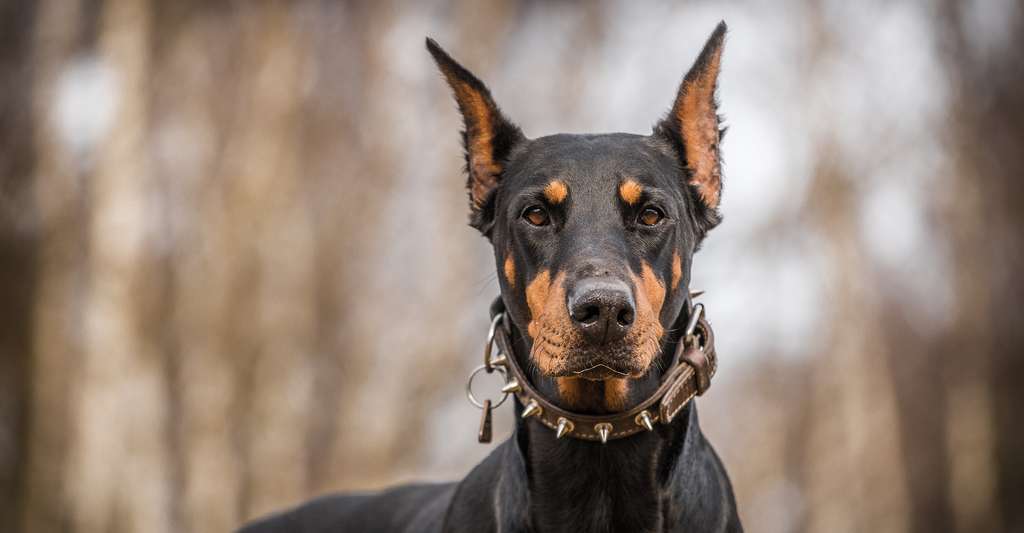

Education na ọzụzụ
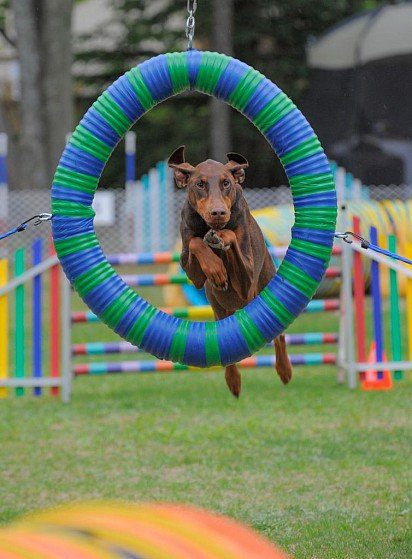

Doberman is one of the most easily trainable breeds. But one should not think that it is possible to raise a well-trained, well-mannered dog without making any effort.
You need to work with your pet from an early age. First of all, you should make it clear to the baby who is the boss in the house and the leader of the pack. Without becoming an authority for the animal, you will never achieve the desired results. The dog is very smart by nature and will not follow the commands of the owner if he does not feel his superiority over himself.
Discipline, sequence of actions and perseverance are the main components of success in training and raising a Doberman. You must patiently enforce your commands, however, by no means resorting to violence. Cruelty is the weapon of the weak, and at best your dog will stop perceiving you, and at worst, it can hold a grudge and at one fine moment throw it out on you. Kindness and persuasion act much more effectively on the Doberman.
Love for a puppy in no way means permissiveness. Once you make the decision not to feed your dog from your table, or to not allow him to immediately run into the rooms after a walk, follow the established rules all the time, without making exceptions. But to punish a puppy, especially in pursuit, for gnawed slippers or furniture should not be. Not only will they not understand you, but they will also be offended. This is the worst thing that can happen in a relationship. Your pet should see you as a best friend and like-minded person.
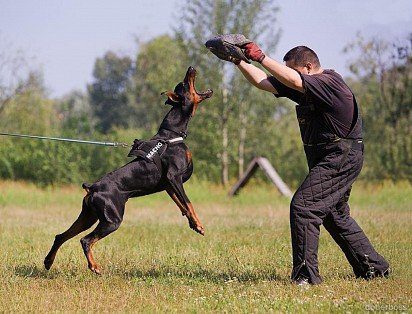

It is necessary to properly organize the process of training a Doberman. First of all, you should teach the puppy to perform basic commands: “Come!”, “Sit!”, “Place!”. Do not forget to reward the dog for success in learning with a treat, or even just a kind, affectionate word.
During walks, give the command “Come to me!” better repeatedly, and not just about to go home. In this case, your pet will not have negative team associations with the completion of an event he loves so much as a walk with the owner.
The home training system should take into account all the features of your Doberman, from his temperament and character traits to gastronomic preferences. Teaching a full course of general obedience, and even more so a course of protective service, is best entrusted to professionals.
A well-trained Doberman is the pride of the owner, the subject of delight and admiration of others.
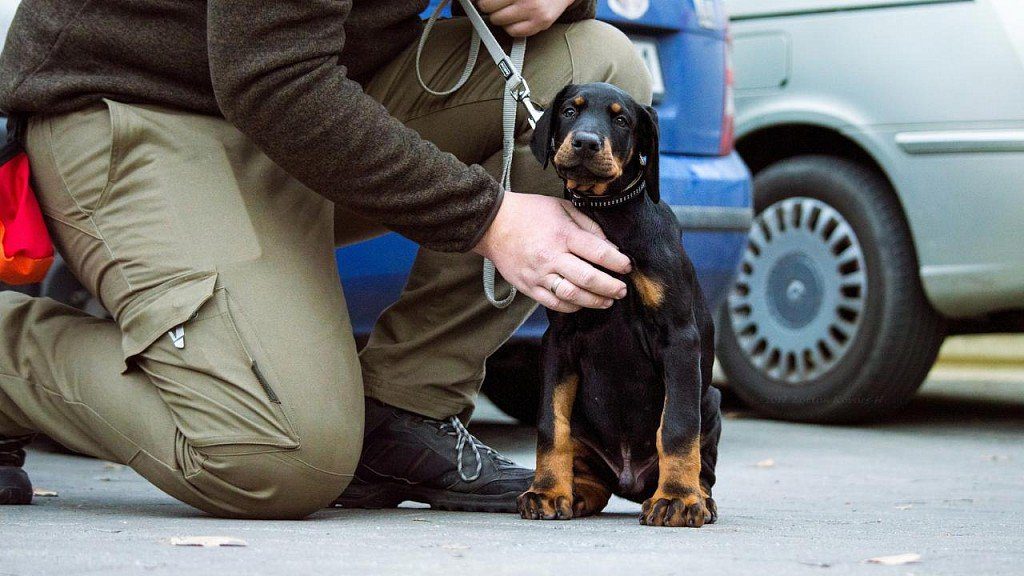

Nlekọta na ndozi
Doberman, as a short-haired breed, is perfect for keeping in a city apartment. If you live in your own house, then you can also settle the animal in a specially equipped aviary, although you still need to let the dog into the house from time to time. The enclosure itself will be correctly placed in the shade, since Dobermans do not tolerate heat very well. The floor in the aviary should be made of boards laid on logs 10-20 cm thick. Although the technical capabilities make it possible to organize the heating of the aviary with the help of narrowly focused infrared heaters, it is better to keep the dog in the house during the cold season.
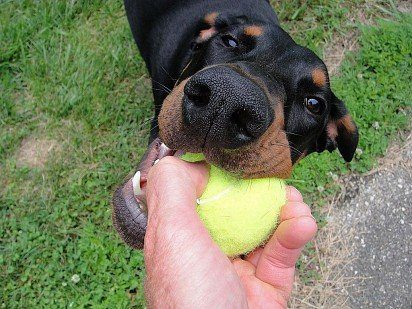

It is very important to organize proper care for a Doberman baby. The room where the puppy lives should be clean and warm enough. Keeping in mind the very high motor activity of dogs of this breed, do not let a hot baby who runs around enough to lie down on the cold floor – he can catch a cold at best, and at worst, earn extremely painful inflammation of the muscle tissue. Rain and snow should not be a reason to cancel the walk, but after it you must definitely let the dog dry and warm in a warm room.
The process of caring for a Doberman does not seem very complicated. You don’t need to comb your coat often. Just wipe your pet once a week with a wet towel, and then comb (or rather massage) the dog’s body with a stiff-bristled brush. Frequent bathing is also not recommended. It will be enough to resort to it once every six months. Moreover, connoisseurs of the breed note a weakening of immunity in Dobermans with regular water procedures. But washing paws after a walk in bad weather is a completely ordinary and harmless procedure.
The ears and eyes of the animal need to be controlled. Periodically, they need to be cleaned with a cotton swab dipped in ordinary clean water.
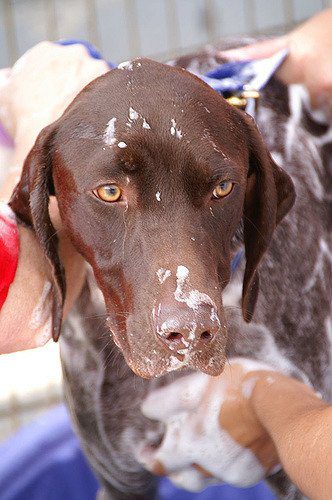

The nails are neatly trimmed as needed – if they are not worn down enough.
The dog’s bedding, toys, food and drink bowls must be kept clean.
Doberman must get enough physical activity. Walking with the dog, which is kept in the house, you need at least two hours a day. In winter, if you do not have special dog clothing, the duration of walks is reduced to reasonable limits.
As food for Dobermans, you can use both dry food and natural products.
When organizing food for an animal, adhere to the following basic rules.
- Premium dry food for large dogs can be used if your pet is between 23-24 kg. For dogs weighing over 25 kg, special dietary formulations are used that block the process of obesity.
- Most of the menu, made up of natural products, should be meat. It is desirable that it be veal. The daily intake for an active adult dog is about 1 kg. Minced meat, offal, fatty meat as an alternative are undesirable.
- The daily diet should include: cereals (except semolina and pearl barley), vegetables (preferably carrots, cabbage, zucchini), low-fat sour-milk products.
For dogs of a “respectable” age, food can be softened in kefir; this method is not used for young individuals.
Proper care of a Doberman also implies constant monitoring by the owner of the health of the animal, adherence to the vaccination schedule.
Doberman health and disease
Despite the fact that Dobermans are classified as healthy dog breeds, there are a number of diseases and hereditary problems that are more characteristic of these animals.
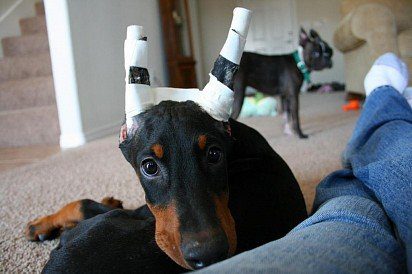

First of all, it is heart disease. Unfortunately, veterinarians diagnose cardiovascular diseases (ischemic disease, tachycardia, arrhythmia, heart failure), even in young animals that have not yet reached the age of five. For the treatment to be as effective as possible, monitor the condition of your pet. Breathing problems, cases of falling while walking, imbalance, convulsive trembling – all these symptoms indicate heart problems that have arisen and are a signal for an immediate visit to the veterinary clinic. Medical treatment is indicated for such animals, and it is better to always carry prescribed drugs with you. Heart problems can also be hereditary. All the same shortness of breath, weakness, up to fainting, may not appear in a Doberman immediately, but already when the disease is running, and it is problematic to cope with it.
Narcolepsy is another genetic “problem” of the Doberman. This is a specific disorder of the nervous system, which manifests itself in a short-term (from a few seconds to 15-20 minutes) drop in muscle tone. The animal becomes completely motionless, the eyes glaze over. Loud noises or body stroking can help bring the dog to its senses. The nature of the disease is not completely clear, and your task remains only to prevent seizures with the help of the advice of a veterinarian.
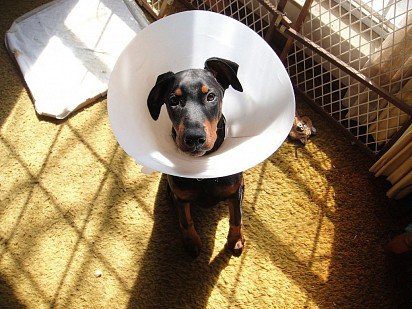

There is a genetic predisposition in Dobermans to the occurrence of gastric volvulus. The provoking factor here is malnutrition. The following symptoms speak of this serious problem – bloating, excessive salivation, abdominal pain, constant urge to vomit and defecate. The dog becomes very nervous. In no case should you hesitate to seek qualified help in the event of such problems.
Unfortunately, Dobermans often suffer from allergies. It can be caused by house dust, plant pollen, molds. Among the most serious problems resulting from allergic reactions may be the occurrence of sacral licking granuloma in your pet. The disease is very difficult to treat, and simple drug therapy is no longer enough.
Proper care, balanced nutrition, timely vaccination, systematic preventive examinations at the veterinarian, love and care are the main conditions for maintaining your pet’s good health.
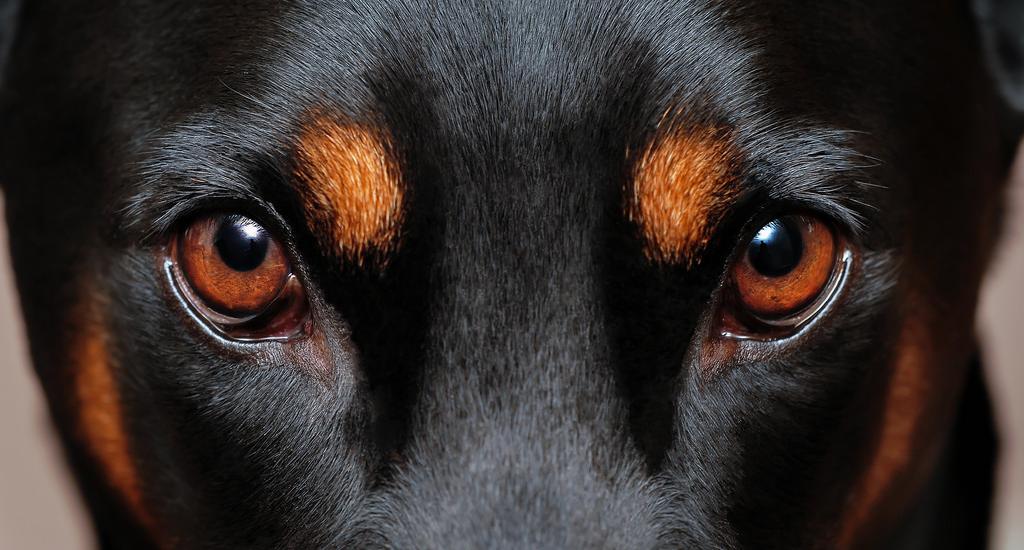

Otu esi ahọrọ nwa nkita
When buying a small Doberman, of course, you want to see a reliable, loyal and intelligent dog next to you. It largely depends on how responsibly you approach the choice of a puppy.
The question of where to buy a dog should be decided without alternative – only in a specialized kennel or from experienced breeders with a good reputation. Buying in the bird market or over the Internet in the vast majority of cases is not justified.
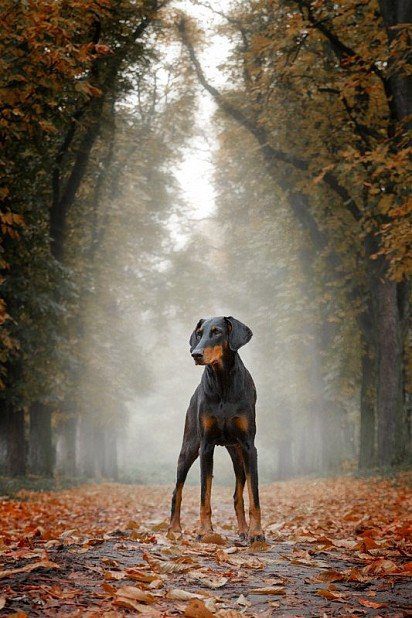

It is very important to determine the gender of the puppy. The choice, as you know, is small, but still there. The Doberman girl is usually more affectionate and attentive. The role of a formidable and self-confident companion-defender is better handled by a male.
Even a short conversation with a breeder can tell an attentive person a lot. People who love dogs and treat their breeding responsibly can be seen right away. They will answer all your questions with pleasure and knowledge of the matter, give recommendations on the care and maintenance of the animal. Professional breeders themselves usually offer their clients to familiarize themselves with training diplomas (both in general obedience and in the course of protective service) of the parents of the puppies. This, to a certain extent, guarantees that your chosen one has the necessary working qualities.
It is very important to evaluate the behavior and appearance of the mother dog. Her coat should be smooth and shiny, her eyes should be lively and clear. In relation to you, she should behave cautiously, even with a certain amount of tension, but not hysterically aggressive.
When examining a Doberman puppy, pay attention to the following points:
- the baby should have a wide back and strong bones;
- the body is almost square, the neck is long;
- the jaws are quite wide, even a small Doberman has a well-defined chin;
- the tummy is soft and painless, without signs of an umbilical hernia;
- the coat is smooth, not dull.
A healthy baby is active and inquisitive, but cowardice and lethargy are not typical for the “correct” Doberman baby.
Curvature of the paws, traces of discharge from the eyes, white spots on the skin, a swollen belly, protruding ribs indicate that the puppy is not completely healthy.
By the age of one and a half months, the tail of the baby should already be docked, and the wound should heal well. At 1.5 months, many breeders stop the puppy’s ears, although this is not always practiced. You can safely buy a “burdock”, but in this case, remember that all the problems associated with bringing the appearance of your pet to the requirements of the standard will fall on your shoulders.
A responsible breeder, along with the animal, must give you a puppy card, which contains data on all vaccinations performed. The number of this document necessarily coincides with the number of the brand, which is usually applied on the stomach, less often on the dog’s ear.
Photo of doberman puppies
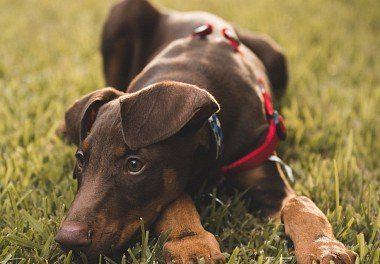

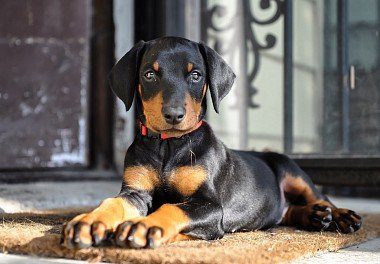

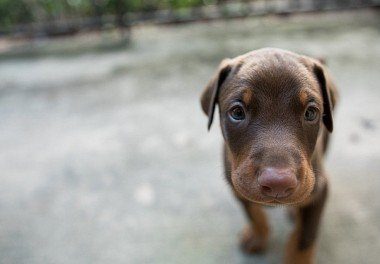

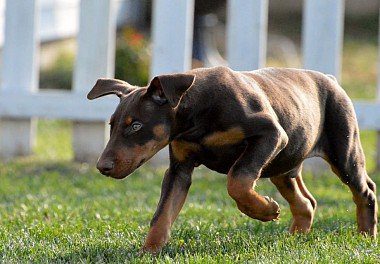

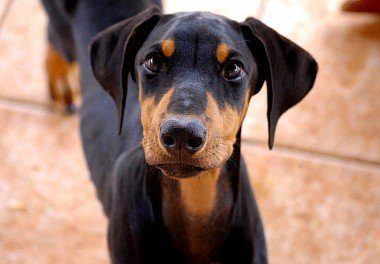

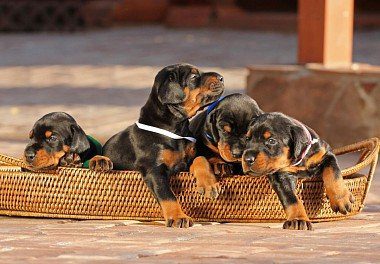

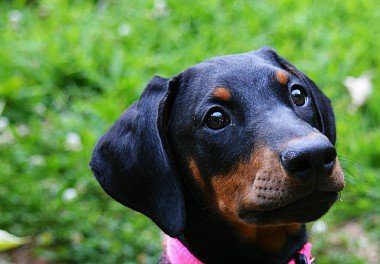

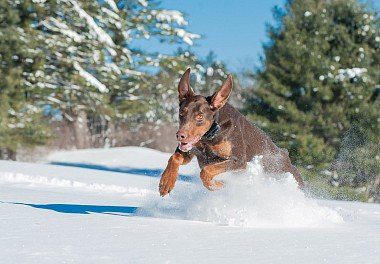

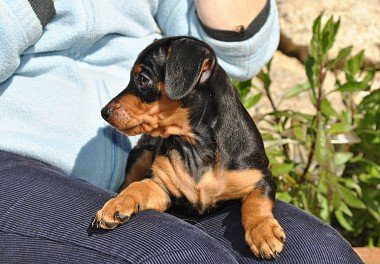

How much does a doberman cost
Statistics show that the price of a Doberman puppy ranges from 250 to 600$. Nurseries engaged in breeding elite representatives of the breed can request up to 900$.
Prices for Doberman puppies sold at the bird market or through private ads on the Internet, of course, can be noticeably lower, but if such a baby eventually grows out of not quite, or not at all, a Doberman, you will have only yourself to blame.
The smallest amount you will have to pay for a pet class puppy. Such animals have signs, sometimes almost imperceptible to the layman’s eye, due to which they will not be allowed to be bred and will never become champions. But, if you are not ambitious and just looking for a good friend and companion, a Doberman of this class is what you need.
Breed class is the basis of the breed. Dogs of good blood, fully conforming to the standard, suitable for breeding work. The cost of such a Doberman will already be noticeably higher.
Show class – the best of the best, elite puppies. Such babies are not born every day and not in every couple, so the price for them is appropriate.





